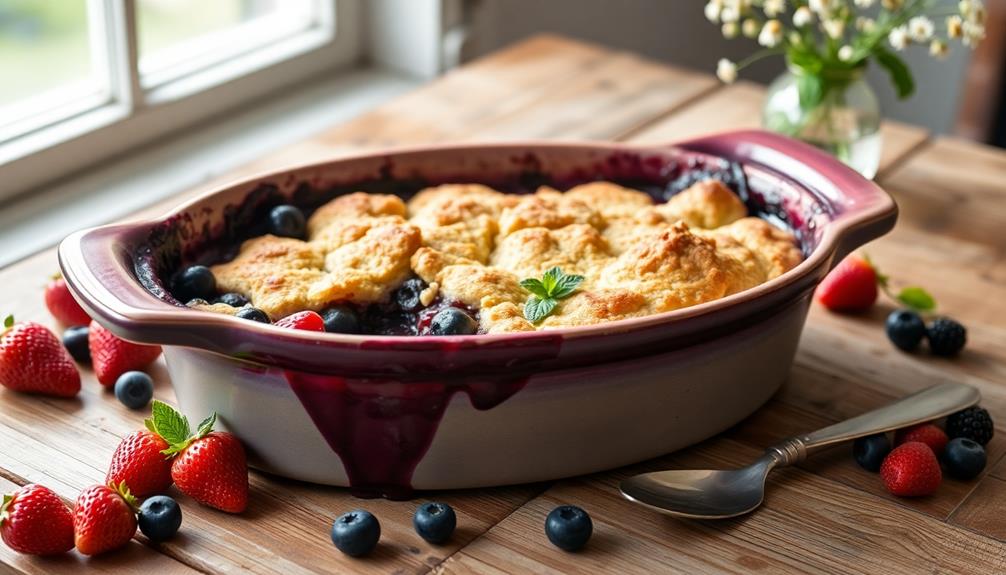Nettles and potatoes combine for a comforting, nourishing soup enjoyed across Europe for centuries. You'll love the earthy, balanced flavors. First, sauté onions and garlic, then add potatoes and broth. Towards the end, toss in fresh nettle leaves – their vitamins and minerals make this soup super healthy. The potatoes provide carbs for energy, while the high fiber keeps you feeling full. This budget-friendly dish is easy to customize with different herbs or veggies. Discover how versatile this soup can be as you continue exploring its benefits.
Key Takeaways
- Nettle and potato soup is a traditional dish with a history traced back to ancient Greece and Rome, where nettles were used as a survival food.
- Nettles are highly nutritious, containing essential vitamins, minerals, antioxidants, and fiber, making them a healthy addition to this comforting soup.
- The recipe involves sautéing onions and garlic, then adding potatoes, nettles, and broth to create a flavorful and satisfying soup.
- Proper handling and cooking of nettles are crucial to remove bitterness and enhance the overall taste and texture of the dish.
- The versatility of the recipe allows for adaptations with different herbs, seasonal vegetables, and the ability to adjust consistency and serve as a base for other soups or stews.
History
Nettles, with their stinging leaves, have long been a part of culinary traditions across Europe. These resilient plants have been foraged and used in cooking for centuries, prized for their nutritional benefits and unique flavor.
Interestingly, the earliest known records of nettle consumption date back to ancient Greece and Rome, where the leaves were used in soups, stews, and even as a green vegetable.
During the Middle Ages, nettles became an important survival food, particularly in times of scarcity. Peasants and the working class would gather the wild plants, which were abundant and easy to obtain, to supplement their diets.
The nettle's ability to thrive in a variety of soil conditions made it a reliable and accessible ingredient, even in the harshest of environments.
Today, the humble nettle continues to be celebrated in regional cuisines, with nettle and potato soup being a classic example of its enduring presence in European culinary traditions.
Recipe
Nettle and Potato Soup
Nettle, a common weed often found in damp areas, is a surprisingly versatile and nutritious ingredient. Its earthy, spinach-like flavor lends itself beautifully to hearty soups and stews. Pairing it with the humble potato creates a comforting, nourishing dish that's sure to delight the senses.
This recipe showcases the harmony of these two ingredients, resulting in a vibrant, flavorful soup that's both satisfying and easy to prepare. The nettle's subtle bitterness is balanced by the potato's starchy creaminess, making for a well-rounded and deeply satisfying experience.
- 1 lb (450g) fresh nettle leaves, washed and stems removed
- 3 medium potatoes, peeled and diced
- 1 onion, diced
- 3 cloves of garlic, minced
- 4 cups (1 liter) vegetable or chicken broth
- 2 tbsp olive oil
- Salt and pepper to taste
In a large pot, sauté the onion and garlic in the olive oil over medium heat until translucent. Add the diced potatoes and broth, and bring to a boil. Reduce heat and simmer for 15-20 minutes, until the potatoes are tender.
Gently stir in the nettle leaves and continue to simmer for another 5-10 minutes, until the nettle is wilted and tender. Season with salt and pepper to taste.
It's important to handle the nettle with care, as the leaves can cause a stinging sensation on the skin. Be sure to wear gloves when harvesting and preparing the nettle.
The soup can be served as a main course or as a side, and it pairs wonderfully with crusty bread or a fresh salad.
Cooking Steps
First, harvest some fresh nettle leaves from your garden or local forager.
Then, peel and chop the potatoes into bite-sized pieces.
Next, sauté the onions in a pot until they're translucent, about 5 minutes.
After that, add the nettles and pour in the vegetable stock.
Step 1. Harvest Fresh Nettle Leaves

Gather your gardening gloves and a pair of scissors as you venture into the lush greenery to collect the delicate nettle leaves.
These remarkable plants thrive in moist, shaded areas, so keep an eye out for them along the edges of forests or near stream banks. When you spot a nettle plant, gently grasp the leaves near the stem and snip them off, taking care to avoid the prickly stems.
Be sure to wear your gloves, as the leaves contain tiny, stinging hairs that can irritate unprotected skin. Collect only the fresh, vibrant green leaves, leaving behind any damaged or discolored ones.
Aim to gather about a handful of leaves per serving of soup. With your nettle bounty in hand, you're ready to bring their delightful flavor and nutritional benefits to your delectable Nettle and Potato Soup. To begin your nettle soup recipe, start by washing the leaves thoroughly and removing any tough stems. Then, sauté some onions and garlic in a pot before adding the nettle leaves and potatoes. Let everything simmer together until the potatoes are soft, then blend it all up until smooth. This nourishing and earthy soup will warm you up from the inside out, and it’s a fantastic way to enjoy the goodness of foraged nettles.
Step 2. Peel and Chop Potatoes

With the fresh nettle leaves safely collected, turn your attention to the potatoes.
You'll need to peel them first, so grab a sharp paring knife and get to work. Carefully slice off the skin, making sure to remove any eyes or blemishes. Once peeled, rinse the potatoes under cool water to wash away any dirt or debris.
Next, it's time to chop the potatoes into bite-sized pieces. Place them on a cutting board and, using a chef's knife, slice them into thin, even rounds.
Then, stack the rounds and cut them crosswise into cubes. Aim for pieces that are about 1/2-inch to 1-inch in size – this will help them cook evenly in the soup.
As you chop, be mindful of your fingers and use the knife safely. Take your time and focus on creating uniform potato pieces.
With the potatoes prepped, you're ready to add them to the soup and let the flavors meld together.
Step 3. Sauté Onions Until Translucent

Having peeled and chopped the potatoes, you'll now sauté the onions until they're translucent.
In a large pot or Dutch oven, heat a couple of tablespoons of olive oil over medium heat. Once the oil is shimmering, add the diced onions.
Stir the onions occasionally, letting them cook for about 5-7 minutes. You'll know they're ready when they've softened and turned a lovely, pale golden color.
Be careful not to let them brown too much, as you want the onions to be sweet and aromatic, not caramelized.
As the onions sauté, they'll release their natural sugars, creating a delightful aroma that will fill your kitchen.
This step is crucial for building the flavor base of the soup, so take your time and enjoy the process.
Once the onions are perfectly translucent, you can move on to the next step in creating your delicious Nettle and Potato Soup.
Step 4. Add the Nettles

Next, add the freshly harvested nettle leaves to the pot. Be careful when handling the nettles, as they can sting your skin.
Gently add them to the sautéed onions, stirring to combine. The nettles will quickly wilt down, releasing their earthy, bold flavor into the soup. Allow the nettles to cook for about 2-3 minutes, until they've softened. Their vibrant green color will contrast beautifully with the golden onions.
Nettles are packed with essential vitamins and minerals, so you're getting a nutritious boost in this soup.
Once the nettles have wilted, it's time to add the potatoes. Carefully cube the potatoes and gently stir them into the pot. The nettles and potatoes will now simmer together, blending their flavors and textures to create a hearty, comforting soup.
Get ready for the delicious aroma to fill your kitchen!
Step 5. Add Vegetable Stock

After adding the nettles, pour in the vegetable stock. You'll want to use about 4 cups of stock to cover the nettles and potatoes.
Bring the mixture to a gentle simmer, then let it cook for 15-20 minutes. This allows the flavors to meld and the vegetables to become nice and tender.
As the soup simmers, the stock will infuse the nettles and potatoes with a delicious savory flavor. The stock helps to balance out the slight bitterness of the nettles. You can use a homemade vegetable stock, or opt for a high-quality store-bought version.
Either way, the stock ties all the ingredients together into a harmonious, comforting soup.
Be sure to taste the soup as it cooks and adjust the seasoning as needed. You may want to add a pinch of salt and pepper to enhance the flavors.
The soup should have a nice, velvety texture when it's done. Serve it hot, garnished with a sprinkle of fresh herbs if desired.
Final Thoughts
This nettle and potato soup is a comforting and nourishing dish that showcases the humble ingredients in a delightful way. The combination of earthy nettles and starchy potatoes creates a flavorful and satisfying soup that's perfect for cool evenings or as a light meal.
The key is to handle the nettles carefully and thoroughly cook them to remove any unpleasant bitterness. The potato chunks add substance and creaminess, while the vegetable stock provides a savory backdrop.
Don't be afraid to experiment with different herbs and seasonings to suit your personal preferences. Once you've mastered this recipe, you can easily adapt it to use up other seasonal vegetables or adjust the consistency to your liking.
This soup is a versatile and budget-friendly option that's sure to become a staple in your recipe repertoire. Enjoy the comforting flavors and nourishing benefits of this simple yet delicious nettle and potato soup.
Frequently Asked Questions
Are Nettles Edible, and How Do I Safely Handle Them?
Yes, nettles are edible and packed with nutrients. To handle them safely, wear gloves to avoid the stinging leaves. Gently rinse them and cook thoroughly to remove the sting before enjoying their earthy, spinach-like flavor.
What Are the Health Benefits of Consuming Nettles?
Consuming nettles provides an array of health benefits. They're rich in vitamins and minerals, like vitamins A, C, and K, as well as iron and calcium. Nettles also have anti-inflammatory properties, making them a nutritious addition to your diet.
Can I Substitute Spinach or Kale for Nettles in the Recipe?
You can substitute spinach or kale for nettles in a recipe, but you won't get the same nutritional benefits. Nettles are packed with vitamins, minerals, and antioxidants that spinach and kale may not provide in the same quantities.
How Long Does the Soup Keep, and Can It Be Frozen?
The soup can typically last 3-4 days in the refrigerator and can be frozen for up to 3 months. When ready to serve, simply thaw it in the fridge and reheat it on the stovetop.
Can I Use a Blender Instead of a Hand Blender for the Soup?
You can certainly use a blender instead of a hand blender for the soup. Just be careful not to overfill the blender and work in batches, if needed, to ensure a smooth and consistent texture.










